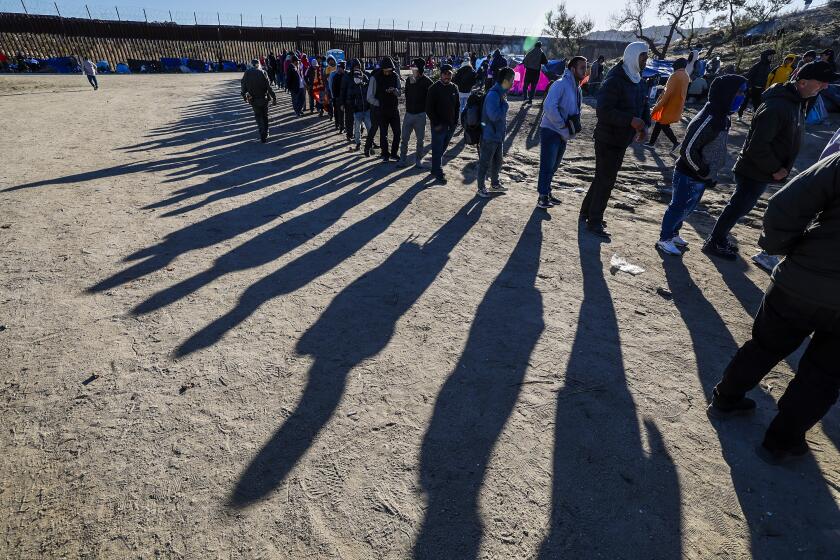Unlawful border crossings dropped to four-year low in November, new data show

- Share via
Unlawful border crossings along the U.S.-Mexico border have dropped to a four-year low, according to U.S. Customs and Border Protection, with 46,610 people stopped between ports of entry in November.
The number of illegal crossings that month marked an 18% decrease from the previous month, and the lowest level since July 2020, the agency said.
“Our enhanced enforcement efforts, combined with executive actions and coordination with Mexico and Central American countries in recent months, are having a sustained, meaningful impact,” said Troy A. Miller, the acting head of U.S. Customs and Border Protection.
Between June and November, the Department of Homeland Security removed more than 240,000 people, according to the agency. In fiscal year 2024, the department also removed more than 700,000 from the country, more than any prior year since 2010.
The numbers represent something of a turnaround for the Biden administration, which faced major political backlash for a surge in illegal crossings earlier in Biden’s term. Trump slammed Biden and Vice President Kamala Harris for the increases.
Immigration experts attribute the drop in border encounters — people stopped trying to cross in areas between ports of entry — to multiple factors, including what they said is the current administration’s “carrot-and-stick” approach.
Under the Biden administration, officials have encouraged migrants to turn themselves in at ports of entry, launching an app to make appointments as they travel through Mexico. It has also discouraged illegal entries between ports of entry, by making those who attempt to enter the country in that manner ineligible for asylum.
The low utilization of E-Verify illustrates a “broken U.S. immigration system” and the lack of economic interests in using it. Employers are desperate for labor, documented or not.
The sharp decrease comes just weeks before President-elect Donald Trump is set to be sworn in, bringing with him an administration that has made cracking down undocumented immigration a top priority. During his campaign, Trump and his top advisors characterized the southern border as out of control and under “invasion,” and promised mass deportations.
In a Time interview, Trump vowed to mobilize the military to help deport millions of undocumented immigrants.
“We have people coming in at levels and at record numbers that we’ve never seen before,” Trump said. “I’ll do what the law allows. And I think in many cases, the sheriffs and law enforcement is going to need help. We’ll also get National Guard. We’ll get National Guard, and we’ll go as far as I’m allowed to go.”
The recent border crossings figures paint a somewhat different picture, however.
Border Patrol agents on the ground have reported a drop in the number of crossings for the last seven months, according to the agency, with a 60% decrease occurring between May and November.
With immigration at the forefront of the presidential election, the southern border has become an increasingly significant down-ballot debate in California.
Officials at the Department of Homeland Security have also touted that the number of people processed for removal has doubled in recent months.
The CBP One app allows migrants traveling through Mexico to make appointments at ports of entry, discouraging them from trying to enter the country through deserts in between to avoid U.S. Customs and Border Patrol agents, said Michelle Mittelstadt, spokesperson for the Migration Policy Institute.
The administration also issued an order making those who make illegal crossings ineligible for asylum, and encouraged the governments of Mexico, Panama and Costa Rica to increase migration controls in their counties.
“November marked the first time ever that a majority of encounters were migrants arriving at a port of entry rather than being intercepted after crossing the border without authorization — proof that this carrot-and-stick approach was taking effect,” Mittelstadt said.
Despite the decrease in border encounters, the incoming Trump administration has continued to promise an aggressive approach to deportations, and some have threatened sanctuary cities and states with consequences if they stand in the way.
Here’s what our new poll shows about how California voters view the situation at the border and plans to change asylum rules.
Tom Homan, acting director for U.S. Immigration and Customs Enforcement during the first Trump administration and “border czar” appointee for the second, has called for increased workplace raids.
He told Fox News that cities that refuse to help federal immigration agencies could face criminal charges.
“If you knowingly conceal or harbor an illegal alien from a police officer, it is a felony,” he said.
Marisa Cianciarulo, dean of Irvine’s Western State College of Law and an expert on immigration and refugee law, said recollections of family separations and detentions during the first Trump administration, as well as recent threats of mass deportations, could also be playing a temporary role in discouraging migrants.
“I think we’re seeing a kind of preemptive response to the new administration,” she said. “There’s fear and anxiety, and they’re going to look for other means to support their families.”
Trump’s incoming deputy chief of staff for policy, Stephen Miller, also sent out letters to a number of California officials, cities and counties, warning them of possible consequences if they interfered with immigration enforcement.
For the record:
10:04 a.m. Jan. 2, 2025A previous version of this story said the mayor of Chula Vista was invited to testify in a House Judiciary Committee hearing. The mayor of Vista was invited.
In September, Rep. Darrell Issa (R-Bonsall) and other members of the House Judiciary Committee held a field hearing in San Diego County on the border crisis, inviting mayors of Santee and Vista, law enforcement officials and residents to provide testimony.
In his opening statement, Issa, whose district includes large portions of San Diego County, said that while there are people who legitimately seek asylum and have worked toward entering the country legally, there are millions who have entered the country illegally.
“It is our goal to restore the rule of law and recognize that we can have legal immigration in our country but only if we can control the border, “ he said.
Issa could not immediately be reached for comment.
At the hearing, Santee Mayor John Minto said that the Biden-Harris administration’s approach to border security and immigration was affecting not only the state but San Diego County, which was at the forefront of the issue. He said that between September 2023 and May 2024, San Diego County received up to 154,000 street releases of migrants, many of whom were placed in trolleys and sent to the eastern region of the county.
“These unofficial figures underscore the unprecedented and grave scale of the region’s border crisis,” he said. “The influx of migrants has drained local resources, including overcrowding at local hospitals, prompting San Diego County officials to respond with a coordinated effort involving federal, state and regional support.”
Minto could not immediately be reached for comment.
Earlier this month, San Diego County passed a new policy that would prevent jail officials from cooperating with immigration officials in any way.
The policy went beyond the state’s current law, which allows local jurisdictions to notify immigration officials when someone convicted of certain violent or sexual felonies is set to be released from jail. Under the new policy, San Diego would not provide release dates to federal officials.
The policy has triggered a standoff between county supervisors and the San Diego County Sheriff, who said she would continue to cooperate with federal immigration officials as state law allowed.
California officials anticipate conflict with the new administration. California Atty. Gen. Rob Bonta has called the letters from Miller’s America First Legal a “scare tactic.” Bonta said the state is preparing for legal challenges.
But Cianciarulo warns that punitive policies on migrants tend to have only temporary impacts. If economic and political factors push people out of their home countries, and they’re lured by the prospect of work in the U.S., migrants will eventually take the risk.
“Regardless of how strict the laws are, how punitive, we still come back to the fact that immigration is an economic reality,” Cianciarulo said. “[Migration] is not an emotional type of decision.”
More to Read
Sign up for Essential California
The most important California stories and recommendations in your inbox every morning.
You may occasionally receive promotional content from the Los Angeles Times.















